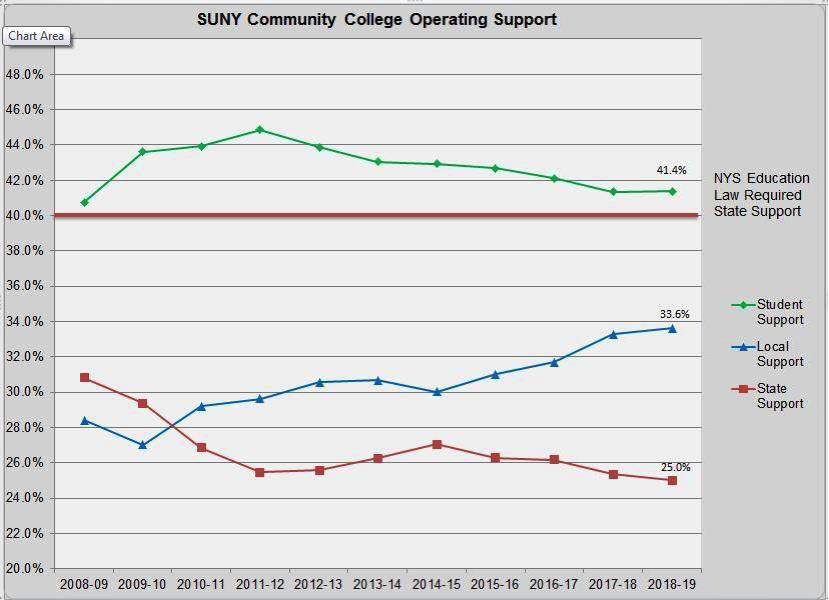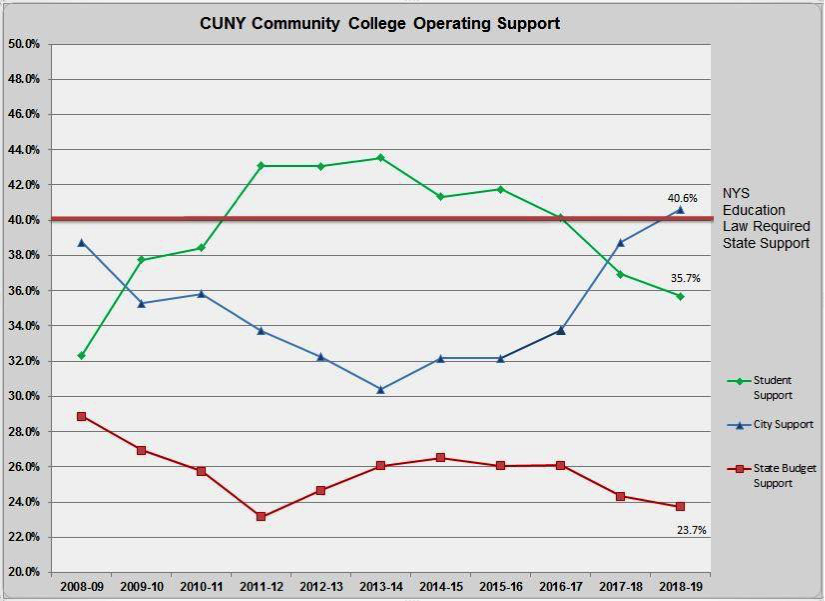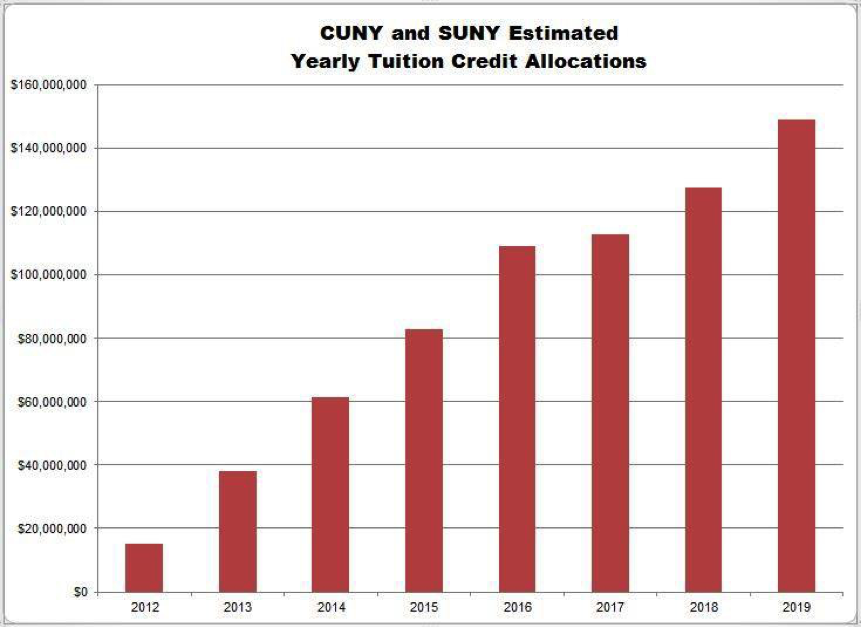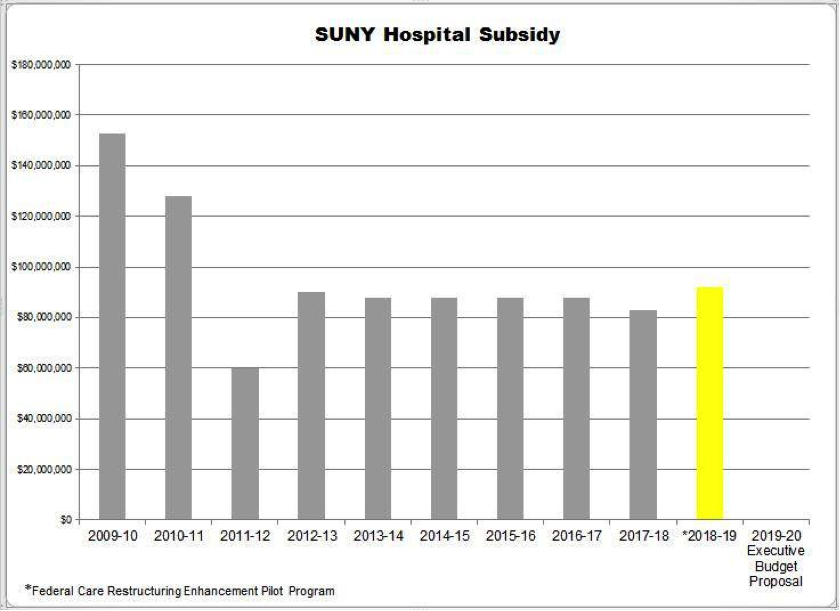Testimony of Andrew Pallotta, President, New York State United Teachers, to the Senate Finance Committee, Liz Krueger, Chair, and Assembly Ways and Means Committee, Helene Weinstein, Chair, on the Proposed 2019-20 Executive Budget for Higher Education, January 28, 2019.
Chairperson Krueger, Chairperson Weinstein, honorable members of the Legislature and distinguished staff, I am Andrew Pallotta, President of New York State United Teachers (NYSUT). NYSUT represents more than 600,000 teachers, school-related professionals, academic and professional faculty in higher education, professionals in education, in health care and retirees statewide.
Thank you for the opportunity to testify today on the proposed 2019-20 New York State Executive Budget for Higher Education. My testimony represents the concerns of over 80,000 faculty and professional staff who work in colleges and universities across the state. These include the members of United University Professions at the State University of New York, the Professional Staff Congress of the City University of New York and the faculty and staff at nearly all the SUNY community colleges in this state.
I am joined today by Dr. Frederick Kowal, President of United University Professions (UUP), and by Dr. Barbara Bowen, President of the Professional Staff Congress (PSC). You will hear from both Dr. Kowal and Dr. Bowen in a few moments.
Quality public higher education is a crucial component in the state’s efforts to recruit and retain businesses and industries. As businesses consider where to locate, they are drawn to locations with an available pool of highly trained and educated employees. The State University of New
York (SUNY) and the City University of New York (CUNY) help to fulfill that requirement, by training and preparing New Yorkers for current and future job opportunities. A growing number of employment opportunities require advanced degrees. This further emphasizes the need for state investment in public higher education to ensure that all New Yorkers have access to an affordable, quality education as offered by CUNY and SUNY. Now is the time for New York to renew its commitment to, and investment in, our public higher education institutions.
State Investment
In recent years, we have seen actions taken to increase student access to public higher education. The enactment of the Excelsior Scholarship Program highlighted the importance of New York’s public higher education institutions. As we enter the final year of a three-year phase-in, we are calling on the state to provide an investment in CUNY and SUNY.
The executive budget holds SUNY’s and CUNY’s instructional core budgets flat from last year’s funding level. Unfortunately for our students, this has been the case for many years and needs to be addressed. While funding for instructional core budgets has remained flat, operational costs continue to rise. Without funding to address these operational costs, we are endangering student access to public higher education and the quality of the education they receive. A state investment is needed to reverse this trend and to preserve and enhance the quality of education received.
The current maintenance of effort language (MOE) language in the education law was intended to shield the four-year colleges operated by SUNY and CUNY from year-to-year cuts and budget fluctuations. While the intent was laudable, the existing MOE, also known as the basic MOE, created a ceiling rather than a floor for funding. In the absence of a significant state investment in CUNY and SUNY, real growth and system-wide programmatic enhancements to the number of faculty, staff, programs and services students receive has been virtually non-existent.
We would like to thank the Legislature for once again unanimously passing legislation (S.7259- A LaValle /A.10620 Glick) to enact an enhanced maintenance of effort, covering all mandator costs for which the state would have to provide funding, as well as, require the state to cover a portion of the tuition credit. Unfortunately, this bill was vetoed. When we refer to an investment, we are asking the state to cover all mandatory costs, which include collective bargaining increases, energy and other inflationary costs as well as the tuition credit waiver. Without state funding to cover these rising costs, CUNY and SUNY are forced to absorb them, which often necessitates reductions in academic programs and student supports.
We thank Assemblymember Glick for holding a hearing on the MOE in December. Dr. Bowen and Dr. Kowal testified at the hearing and discussed how the absence of funding for mandatory costs is impacting students and campuses. At this hearing, Dr. Bowen and Dr. Kowal spoke about potential academic program closures and student support centers drastically reducing their hours/student access due to a lack of funds. The impact of flat funding is being felt by many students across the state and is not anecdotal. It is also being felt by our members. In the case of SUNY, campuses are facing difficult decisions concerning the potential elimination of programs, declining student services due to inadequate resources.
At CUNY, the PSC is currently in contract negotiations and the university has been unwilling to put a financial offer on the table because they do not have the funding to make an offer. Nor do they have the financial commitment from the state to fund the costs of a new contract.
Meanwhile, adjunct faculty who make up the vast majority of the instructional staff, are not being paid a living wage.
These situations must be addressed. They are a direct result of austerity budgets to our public university systems stemming back to 2011.
NYSUT asks the Legislature to make operating aid for public higher education a priority in this year’s budget negotiations. You will hear more on this issue from Dr. Kowal and Dr. Bowen in a few moments.
Faculty
For a number of years, NYSUT has advocated for a faculty initiative to increase the number of full-time faculty and to address adjunct-pay parity issues. Additional faculty equates to more course offerings so that students are able to take the courses needed to graduate on-time. More faculty also translates into smaller class sizes and more time for critical one-on-one academic advisement.
Due to a lack of state investment in faculty, both systems have over-relied on adjunct faculty. These adjunct faculty members are over utilized, grossly underpaid and often exploited.
Increased state operating aid is desperately needed to address this longstanding issue, especially as it relates to adjunct pay. Many adjunct faculty members work on several campuses trying to piece together a salary to support themselves and their families. We all understand the vital role that faculty plays in educating our students and helping them develop the skills they will need to enter the workforce. Yet many of these faculty members are not compensated appropriately.
As we approach the third and final year of the Excelsior phase-in, we continue to call for an investment in faculty. When the program was first implemented, it was our understanding that funding would first be provided to students to cover the cost of tuition, and that the funding necessary for the expansion of programs and services would follow. Unfortunately, to date, the funding to support the hiring of faculty and staff has not been provided. Additional faculty and staff are desperately needed to ensure that all students have timely access to advisement services and course offerings to assist them in completing their education on-time. A student should not have to delay graduation and incur additional debt because they took the wrong course or had to wait a semester or more for a required course to be offered.
With the implementation of the predictable tuition plan in 2011, tuition increases were supposed to be used to support an investment in classroom faculty, instruction initiatives to support on- time completion and the tuition credit, which I will address shortly. For years, NYSUT has argued that the students have paid more than their fair share through tuition increases, and it is time for the state to cover more of the costs.
The state aid appropriation for CUNY and SUNY continues to include set-aside funding ($12M Cuny/$18M SUNY) with language to permit the systems to use the money to hire new classroom faculty. In prior years, this funding was intended for performance-based funding. NYSUT is pleased to see that the appropriation continues to allow the funding to be used for the hiring of new faculty, however, this funding is not sufficient. Due to years of flat funding, this set-aside is typically used by CUNY and SUNY for operational and programmatic needs and does not support adding needed faculty.
Community Colleges
At this time, I would like to discuss community colleges. I thank the Legislature for your continued efforts to support these campuses and your continued efforts to secure state base aid increases for community colleges. As you know, community colleges educate and prepare students for the workforce as well as provide the foundation for those students who move on to four-year campuses or universities. Community colleges teach all types of students, they help to advance social mobility and are located where students live and work. They often collaborate with regional businesses and employers to develop and provide training to address local workforce needs.
Notwithstanding the Legislature’s commitment to community colleges, state funding to these campuses is not commensurate with the provisions of the state education law. State education law stipulates that the state shall pay 40 percent of the operating costs of these campuses, however, the state is not meeting its obligation.
As the attached charts A and B illustrate, both SUNY and CUNY community college students are paying the lion’s share of operating costs of these campuses. Over the ten-year period from 2008-09 to 2018-19, SUNY community college students went from paying 40.8 percent of the operating costs to approximately 41.4 percent. While the state’s contribution for the same period decreased from 30.8 percent to 25 percent. We see a similar trend for CUNY community colleges during the same time period, where the student share increased from 32.3 percent to
40.6 percent, while the state share decreased from 28.9 percent to 23.7 percent.
The executive budget proposes flat funding per full-time equivalent (FTE) student for community colleges, which will likely force these campuses to raise tuition and/or eliminate programs and student services. While state base aid funding is flat, some of our community colleges will receive less state funding due to enrollment fluctuations.
In order for our campuses to maintain and enhance academic programming and supports, their state funding needs to be increased. Even though enrollment on some campuses has decreased, operational costs have not. Our campuses rely on state funding to offer programs and student services that not only respond to current and future business needs, but will also attract potential students. In the absence of predictable funding, campuses are forced to raise tuition and/or limit courses and programs, which diminish their appeal to future students and potential business partners.
NYSUT urges the Legislature to increase base aid by $250 per FTE student. This would raise the per student level of spending to $3,097 – this amount would greatly mitigate the impact of a loss of state aid due to enrolment fluctuations. We thank the Legislature for their historical support in restoring FTE funding to community colleges, and we believe now is the time to provide base line funding to financially stabilize our campuses.
During NYSUT’s Representative Assembly in the spring of 2018, our members passed a resolution on funding for community colleges. Pursuant to that resolution, our members call upon the Legislature to create a task force of relevant stakeholders, to reform the community college funding methodology to provide a strong, stable funding method for New York’s community colleges. NYSUT has, and continues to be, open to conversations regarding a change to the methodology to provide a predictable and reliable state funding stream. However, we are opposed to any change that would expand SUNY System Administration’s authority over these campuses. It is extremely important to us that these campuses retain their autonomy – after all, they are called “community colleges” for a reason.
Community College-Family Empowerment Community College Pilot Program. The executive budget provides $5 million ($3M for SUNY/$2M for CUNY) in funding to create the Family Empowerment Community College Program to serve 400 single parents. According to material accompanying the budget, this program will provide educational and student supports, such as tutoring, child care and career counseling as well as other services needed to help students graduate. NYSUT is supportive of the intent of this program and the recognition that more is needed to support students and their academic pursuits. However, we seek the full restoration of child care programs at community colleges as well as the Accelerated Study in Associates Program at CUNY. These programs provide much needed support to help all students complete their education. In the absence of these programs, student attendance, participation and success are compromised.
Tuition Assistance Program (TAP) Gap
Both SUNY and CUNY four-year campuses have been grappling with the growing tuition credit, which is an unfunded mandate that started in 2011 with the enactment of the tuition plan. All TAP students receive a tuition credit based on their income; with higher-income students receiving the lowest credit and lower-income students, who receive a maximum TAP award, getting the highest credit to fully cover the cost of their tuition.
As noted in the attached chart C, you can see the rapidly rising cost of the TAP tuition credit, which now stands at nearly $130 million for both SUNY and CUNY and will grow to at least $150 million in 2019-20.
It is our understanding that a $200 tuition increase would cost each system an additional $10-15 million. Campuses with high numbers of TAP students are penalized by the need to cover the TAP Gap without any state reimbursement. Existing law ensures that TAP students receiving a maximum award are made whole and provided access to CUNY and SUNY. Unfortunately, however, that access is compromised by the tuition credit. As noted above, the TAP Gap increases with every tuition increase, which is intended to cover the tuition credit along with other costs. Since the tuition credit has quickly grown over the years, institutions are left with less or very little money to invest in new faculty and other student initiatives to support on-time completion.
We thank Assemblymember Glick for recognizing the importance of this issue and the financial and programmatic impact it has on campuses by introducing legislation (A.720) to require the state to reimburse campuses for the tuition credit issued as a result of a tuition increase. While this legislation would not cover the full cost of the tuition credit, it would go a long way to mitigate the current situation.
SUNY Hospitals
I would now like to talk about the SUNY hospitals. I want to thank the Legislature for again restoring some of the funding provided to the hospitals in last year’s enacted budget.
Unfortunately, the 2019-20 Executive Budget proposes the elimination of the state subsidy to these hospitals. The elimination of the subsidy is deeply troubling.
Over the years (see attached chart D), the state subsidy to these hospitals has been reduced, from
$90 million in SFY 2012-13 to $87.9 million in SFY 2017-18. We are asking the Legislature to restore this funding to 87.9 million. As part of the 2018-19 New York State Executive Budget, the subsidy was eliminated. Working closely with the Legislature, we were able to secure federal funding in place of the state subsidy. Unfortunately, that funding was for one-year only.
The state subsidy is a vital source of funding to the hospitals and was first provided in 2001, in lieu of debt service and fringe benefits, which the state had covered many years ago. The three hospitals operated by SUNY are the state’s hospitals and, as such, the state should provide support to ensure their financial stability and viability, including funding to grow and expand the services needed to keep up with the various advances in health care.
The loss of the state subsidy is further compounded by the drastic reduction in the state match for the Disproportionate Share Hospital (DSH) program. In order to keep within the global Medicaid cap, the state has reduced the state match. As the local sponsor for the three SUNY hospitals, the state has the financial obligation to provide the state match for these hospitals so that they can access federal DSH money for services provided to Medicaid and uninsured patients. Yet, SUNY hospitals have instead been forced to pay the state match. These facilities must identify funds they can use to cover DSH costs. These funds are often drawn from accounts that could be used to improve patient services, provide capital improvements or hire additional staff to address shortages. Therefore, by not providing the state share of the DSH, the state has compromised the financial viability and the capacity of these facilities to serve their patients and communities.
In the current fiscal year (SFY 2018-19) alone, these hospitals are owed $83 million in state DSH matching funds, forcing these facilities to use their own funds in order to access $167 million in federal DSH payment due to them for patient services rendered. While NYSUT is appreciative of the proposed additional $60 million in DSH funding provided in the executive budget for these hospitals, again they are still owed the $83 million for services they have already provided to uninsured patients in the current fiscal year.
You will hear more from Dr. Kowal regarding the impact of the enhanced MOE on the SUNY hospitals.
For-Profit College Accountability
NYSUT is pleased to see article VII language included in the executive budget that would enact accountability measures for for-profit colleges. As the federal government rolls back oversight protections for these institutions, measures such as those proposed in the executive budget are much needed. A report issued by the Century Foundation entitled “Grading New York’s Colleges” revealed disturbing facts regarding for-profits and their track record of leaving students with more debt. The findings showed that 38 percent of for-profit schools leave a majority of their graduates with earnings below those of an average worker with a high school diploma. The study also found that one-in-four New Yorkers in default on student loans attended a for-profit school, even though these schools enroll only seven percent of New York students.
These institutions often rely heavily on advertisers and marketing to recruit potential students and spend little on instruction. According to the Century Foundation report, in 2015, for every dollar of tuition revenue received, for-profit schools spent $0.41 on instruction. This number is less than half of what non-profit schools spend on instruction, which is $0.86.
The provisions in the executive budget seek to limit the amount of taxpayer revenue they receive; require them to spend at least 50 percent of revenue on instruction; disclose salaries of college presidents and senior leadership along with salary incentives and bonuses – all of which are a strong first step toward enacting protections for students who attend for-profit colleges.
These safeguards will help to ensure that taxpayer dollars spent on tuition assistance programs are going to instruction, as intended. We ask that you adopt these proposals in this year’s enacted state budget.
Student Financial Aid and Opportunity Programs
NYSUT urges the Legislature to continue to invest in student opportunity programs that provide greater student access and remediation services for students in need. We urge you to restore the funding cut to student opportunity programs in the 2019-20 Executive Budget.
We also support updating the 40-year old Tuition Assistance Program (TAP). This program has afforded so many students the ability to obtain a higher education in this state, but it needs to be updated. Too many students are now excluded from, or underserved by TAP. We applaud the Legislature for passing the DREAM Act and look forward to the governor signing this measure into law.
Conclusion
New York State has taken steps to increase student access to public higher education. Now is the time to focus on preserving and enhancing the quality of the education offered by CUNY and SUNY.
We understand that the table target typically allotted to the higher education table is limited and does not allow for new investments after funding is restored to programs such as the student opportunity programs. However, we again call upon the Legislature to make higher education funding a priority this year and set-aside funding outside of the table targets to make a strong investment in the core instructional budgets of CUNY and SUNY. An investment is needed to reverse the impact of years of flat-funding and to ensure that we are providing our students the first-rate education they deserve.
Again, thank you for the opportunity to testify today. I will now turn it over to Dr. Kowal who will be followed by Dr. Bowen.
AR/AB 46451
1/23/19
Chart A

Chart B

Chart C

Chart D
